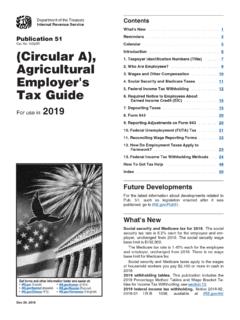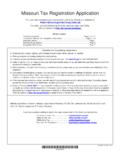Transcription of 2022 Publication 926 - IRS tax forms
1 Userid: CPMS chema: tipxLeadpct: 100%Pt. size: 10 Draft Ok to PrintAH XSL/XMLF ileid: .. tions/P926/2018/A/XML/Cycle06/source(Ini t. & Date) _____Page 1 of 17 15:39 - 23-Jan-2018 The type and rule above prints on all proofs including departmental reproduction proofs. MUST be removed before of the TreasuryInternal Revenue ServicePublication 926 Cat. No. 64286 AHousehold Employer's Tax GuideFor use in 2018 Get forms and other information faster and easier at: (English) (Espa ol) ( ) ( ) (Pусский) (Ti ngVi t) ContentsWhat's You Have a Household Employee?..3 Can Your Employee Legally Work in the United States?..3Do You Need To Pay Employment Taxes?..4 Social Security and Medicare Unemployment (FUTA) You Need To Withhold Federal Income Tax?
2 8 What Do You Need To Know About the Earned Income Credit?..9 How Do You Make Tax Payments?..9 What forms Must You File?..10 What Records Must You Keep?..11 Can You Claim a Credit for Child and Dependent Care Expenses?..12 How Can You Correct Schedule H?..12 How To Get Tax DevelopmentsFor the latest information about developments related to Pub. 926, such as legislation enacted after it was published, go to 's New2018 federal income tax withholding. Tax legislation enacted on December 22, 2017, ( 115-97) changed the 2018 individual income tax rates. For information about how 115-97 affects 2018 federal income tax withholding and form W-4, Employee's Withholding Al-lowance Certificate, see What's New in Pub. 15. See Pub.
3 505 for information about paying your taxes through fed-eral income tax withholding or by making estimated tax payments. The IRS anticipates that Pub. 505 will be avail-able by the end of February security and Medicare tax for 2018. The social security tax rate is each for the employee and em-ployer, unchanged from 2017. The social security wage base limit is $128, Medicare tax rate is each for the employee and employer, unchanged from 2017. There is no wage base limit for Medicare tax. Social security and Medicare Jan 23, 2018 Page 2 of 17 Fileid: .. tions/P926/2018/A/XML/Cycle06/source15:3 9 - 23-Jan-2018 The type and rule above prints on all proofs including departmental reproduction proofs. MUST be removed before apply to the wages of household employees you pay $2,100 or more in cash in 2018.
4 For more information, see Cash wages, parking exclusion and commuter transpor-tation benefit. For 2018, the monthly exclusion for quali-fied parking is $260 and the monthly exclusion for com-muter highway vehicle transportation and transit passes is $ bicycle commuting reimbursement suspen-ded. Section 11047 of Public Law 115-97 suspends the exclusion of qualified bicycle commuting reimbursements from your employee's income for any tax year beginning after December 31, 2017, and before January 1, for Credit for Late Contributions. We moved the Worksheet for Credit for Late Contributions from Pub. 926 to the 2017 Instructions for Schedule H ( form 1040). The worksheet is used to figure the credit for late contributions if you paid any state contributions after the due date for filing form 1040.
5 We now refer to this worksheet as Worksheet program for professional employer or-ganizations. The Tax Increase Prevention Act of 2014 required the IRS to establish a voluntary certification pro-gram for professional employer organizations (PEOs). PEOs handle various payroll administration and tax re-porting responsibilities for their business clients and are typically paid a fee based on payroll costs. To become and remain certified under the certification program, certi-fied professional employer organizations (CPEOs) must meet various requirements described in sections 3511 and 7705 and related published guidance. Certification as a CPEO may affect the employment tax liabilities of both the CPEO and its customers.
6 A CPEO is generally treated as the employer of any individual who performs services for a customer of the CPEO and is covered by a contract described in section 7705(e)(2) between the CPEO and the customer (CPEO contract), but only for wages and other compensation paid to the individual by the CPEO. For more information, go to Also see Rev-enue Procedure 2017-14, 2017-3 426, available at due date for 2018 forms W-2 and W-3. Both pa-per and electronically filed 2018 forms W-2 and W-3 must be filed with the SSA by January 31, reduction states. A state that hasn't repaid money it borrowed from the federal government to pay un-employment benefits is a credit reduction state. The De-partment of Labor (DOL) determines these states. If you paid any wages that are subject to the unemployment compensation laws in any credit reduction state, your fed-eral unemployment (FUTA) tax credit is reduced.
7 See the Instructions for Schedule H ( form 1040) for more waiver payments. Notice 2014-7 provides that certain Medicaid waiver payments are excludable from income for federal income tax purposes. See Notice 2014-7, 2014-4, 445, available at For more information, including questions and answers related to Notice 2014-7, go to payroll duties. Generally, you're responsi-ble to ensure that tax returns are filed and deposits and payments are made, even if you contract with a third party to perform these acts. You remain responsible if the third party fails to perform any required action. If you choose to outsource any of your payroll and related tax duties (that is, withholding, reporting, and paying over social security, Medicare, FUTA, and income taxes) to a third-party payer, such as a payroll service provider or reporting agent, go to for helpful information on this topic.
8 If a CPEO pays wages and other compensa-tion to an individual performing services for you, and the services are covered by a contract described in section 7705(e)(2) between you and the CPEO (CPEO contract), then the CPEO is generally treated as the employer, but only for wages and other compensation paid to the indi-vidual by the CPEO. However, with respect to certain em-ployees covered by a CPEO contract, a customer may also be treated as an employer of the employees and, consequently, may also be liable for federal employment taxes imposed on wages and other compensation paid by the CPEO to such employees. For more information on the different types of third-party payer arrangements, see section 16 in Pub. of missing children.
9 The IRS is a proud partner with the National Center for Missing & Exploited Children (NCMEC). Photographs of missing children se-lected by the Center may appear in this Publication on pa-ges that would otherwise be blank. You can help bring these children home by looking at the photographs and calling 1-800-THE-LOST (1-800-843-5678) if you recog-nize a information in this Publication applies to you only if you have a household employee. If you have a household employee in 2018, you may need to pay state and federal employment taxes for 2018. You generally must add your federal employment taxes to the income tax that you will report on your 2018 federal income tax Publication will help you decide whether you have a household employee and, if you do, whether you need to pay federal employment taxes (social security tax, Medicare tax, FUTA, and federal income tax withholding).
10 It explains how to figure, pay, and report these taxes for your household employee. It also explains what records you need to Publication also tells you where to find out whether you need to pay state unemployment tax for your house-hold and suggestions. We welcome your com-ments about this Publication and your suggestions for fu-ture 2 Publication 926 (2018)Page 3 of 17 Fileid: .. tions/P926/2018/A/XML/Cycle06/source15:3 9 - 23-Jan-2018 The type and rule above prints on all proofs including departmental reproduction proofs. MUST be removed before can send us comments from you can write to:Internal Revenue ServiceTax forms and Publications1111 Constitution Ave. NW, IR-6526 Washington, DC 20224 Although we can't respond individually to each com-ment received, we do appreciate your feedback and will consider your comments as we revise our tax forms , in-structions, and publications.














